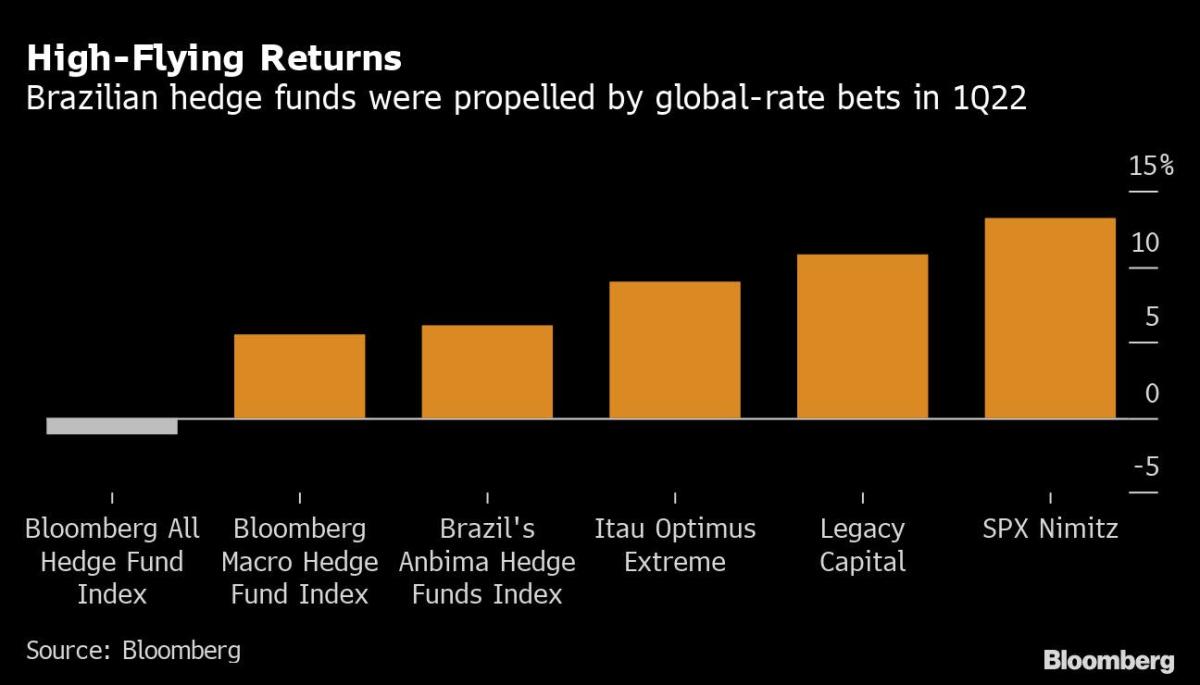
(Bloomberg) — Brazilian traders know inflation. After decades of dealing with wild bouts of it, they consider themselves experts on the topic. Their American counterparts, they say, got complacent.
Years of subdued inflation in the U.S. have lulled them into a false sense of security, as the Brazilians see it. This in turn, the argument goes, led bond trading desks to misread the price spike that began last year and buy the Federal Reserve’s line that the episode would prove little more than a brief blip.
There’s a certain amount of schadenfraude to all of this — “look at those geniuses on Wall Street” — and there undoubtedly have been moments over the past two decades when the Brazilian traders’ hyper-sensitivity to inflation has led them to erroneous calls on U.S. markets. But right now they’re raking it in.
Many of Brazil’s top hedge funds got ahead of the surge in U.S. bond yields this year, correctly betting that the Fed would belatedly realize that it needs to aggressively ratchet up benchmark rates to quell inflation that has reached a four-decade high.
U.S. Inflation Quickens to 8.5%, Ratcheting Up Pressure on Fed
“You can’t keep counting on central banks because they may leave you empty-handed,” said Bernardo Meres, a partner at SPX Capital, which has about 64 billion reais ($14 billion) under management. The firm’s Nimitz fund topped 99% of peers in March, gaining 7.3% for a record monthly advance and pushing the first-quarter return to 13.2%.
Hedge funds like SPX, Legacy Capital and Itau Optimus have seen returns climb as rates soar. After Federal Reserve Chairman Jerome Powell finally signaled a readiness last month to step up the fight against inflation running at an annual pace of 8.5%, U.S. government bonds posted the biggest monthly loss in almost two decades, capping the steepest quarterly rout of the modern era and blindsiding all but a small minority of U.S. investors.
Inverting Yield Curve Signals High Stakes for Fed and Investors
In Brazil, though, a basket of hedge funds rose 6.1% in the first quarter, outperforming the local interbank deposit rate, the benchmark the industry uses to gauge performance, by almost four percentage points. By comparison, the Bloomberg All Hedge Fund Index fell 1.1% in the same period.
Meres, 39, is your prototypical Brazilian money manager. Trained in Rio de Janeiro, home to some of the nation’s most-storied funds, he built his career out of trading rates. Unlike in the U.S., where inflation hadn’t been an issue for decades and macro hedge funds have become an endangered species, in Brazil trading macro trends is the norm. Latin America’s biggest economy saw double-digit price jumps in 2021, 2015 and 2002, after a bout of hyperinflation that lasted through the early 1990s.
While fund managers like Meres were too young to be trading during the peak of Brazil’s inflation, they were mentored by colleagues who struggled through the worst of it.
Latin America’s Central Banks Still Prove More Hawkish Than Fed
Meres started betting on a surge in global rates around the final quarter of 2020, when vaccine progress fueled hopes that the global economy would rebound from the coronavirus pandemic. At that time, low rates abounded and authorities had been doling out unprecedented amounts of stimulus throughout the globe. But Meres believed inflation would soon follow and central banks would need to abandon their dovish stances.
Pablo Salgado, a 43-year-old Rio de Janeiro-based trader who runs the global rates desk at Itau Optimus, which has about 31 billion reais under management, had similar ideas. He has spent the past four months rotating away from trades that profited off a hike in Brazilian rates to mounting similar positions worldwide. The Itau Optimus Extreme fund is one of the nation’s best performers this year, advancing 4.9% last month to push the first-quarter return to 9%.
“Investors in developed markets tend to buy the narrative from policy makers,” Salgado said. “But when you trade emerging markets, especially Brazil, you get better at identifying transformational shocks.”
Legacy Capital’s hedge fund advanced a record 5% last month by betting against U.S. government bonds with positions across different parts of the Treasury bond futures curve and through Eurodollar futures, which reflect the outlook for U.S. rates in certain periods.
Now, it’s also wagering on steeper-than-expected rate increases across the globe. The theory is that central banks will be forced to play catch-up after consistently missing inflation targets, a pattern it’s seen play out over the years in Brazil.
“There’s definitely a lot of leniency with inflation happening around the world,” said Felipe Guerra, the 44-year-old chief investment officer at Legacy Capital, which has 21 billion reais under management. “We’ve seen it happen a number of times: Expectations get out of control, inflation spreads and the central bank is left to chase its tail.”
Amid all the back-slapping and high-fiving in Rio’s hedge-fund circles, there’s one caveat that should be pointed out. Had fund managers used their expertise to call the turn in the domestic stock market, they would have, on the whole, fared a lot better yet. The Ibovespa stock index has soared 11% this year, one of the biggest advances in the world and almost double the average hedge-fund return.
©2022 Bloomberg L.P.